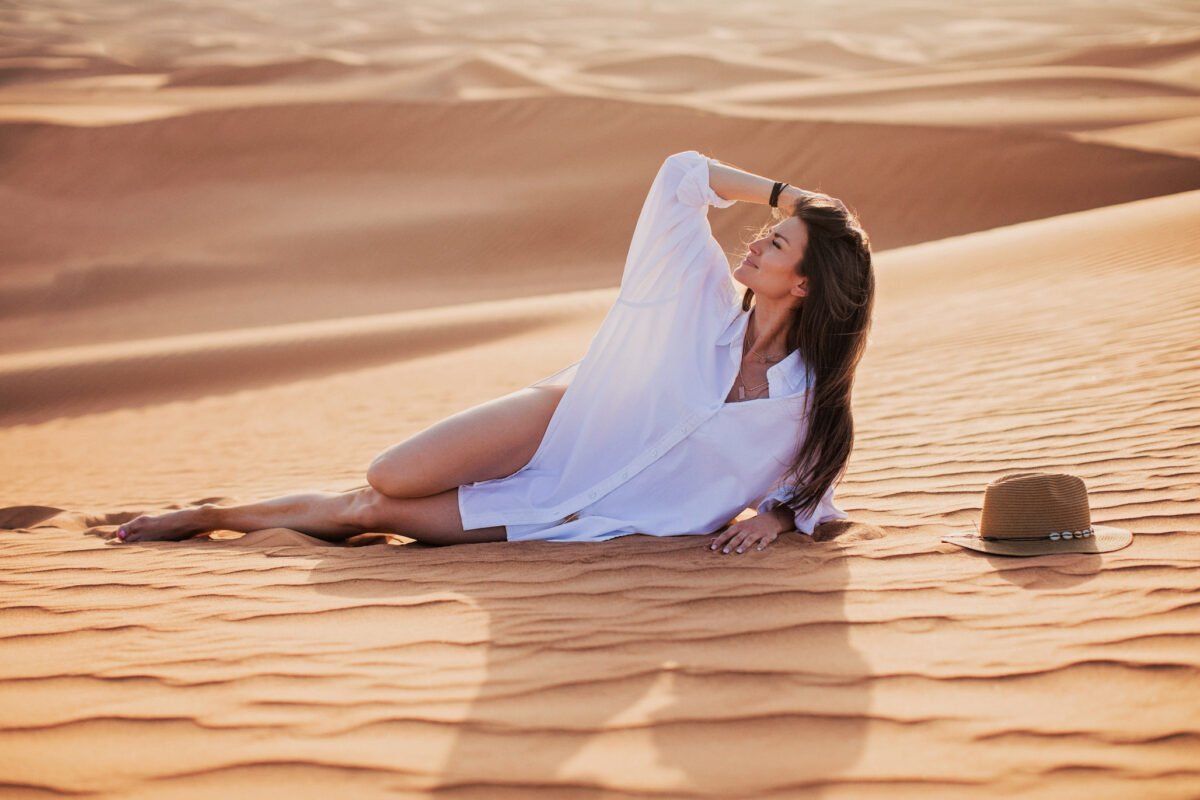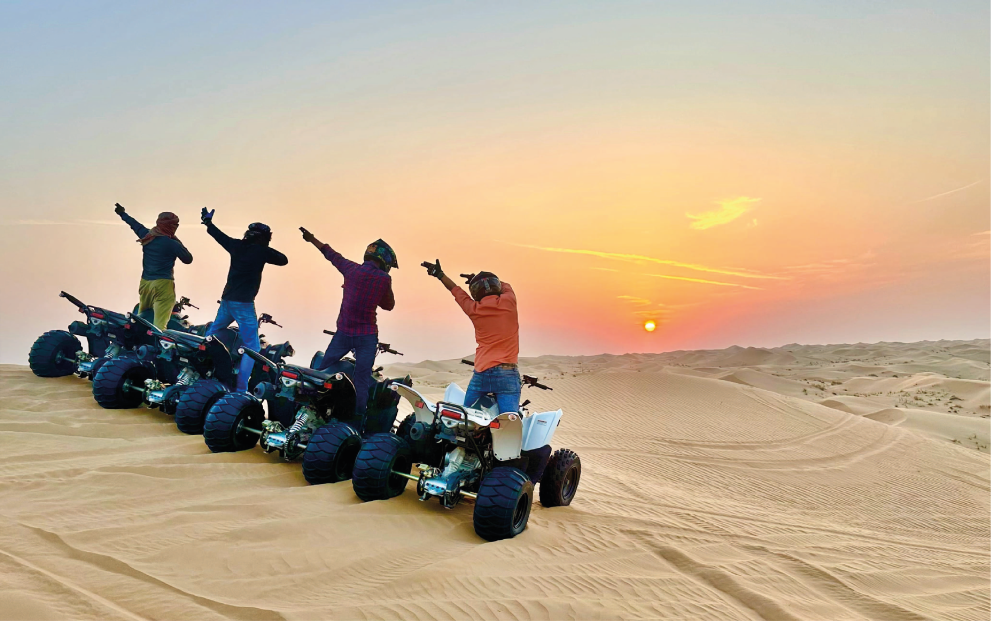Desert Safari Photography:
The sweeping dunes, colorful sunrises, and rich cultural vibes make the Dubai desert a perfect subject for photographers. Whether a skilled photographer or a novice, photography in the Dubai desert landscape demands both technique and vision combined with the environment. Desert Safari Photography Guide
1. The Landscape of the Desert
Dunes offer an endless sea of intricate patterns and textures. Sunrise or sunset light creates long shadows and illuminates the dunes in a way that gives them more form.
- Types of colors: The desert comes alive with the best view of color during sunrise and sunset. Color changes based on temperature, transforming it into a cooler palette in midday. By understanding these color changes, you can catch the land at its most impressive.
- Sky and Clouds: Though clouds are unusual in this part of the world, they can be thrilling when present—if you position yourself looking out over unbroken land or even a sharply defined slope. This next tip is to take the sky into account as a scale and emotive inclusion in your compositions.
Learning the details of these elements can help you predict when to capture such amazingly gorgeous desert moments.

2. Optimal Times for Photography
Just in the nick of the City to Explore before nightfall
- Golden Hour: The ultimate time to shoot in the desert is the golden hours: an hour or a little more after sunrise and sunset. The soft, warm light increases the texture of the sand and establishes an enchanting mood.
- Midday Light: Midday light is hard and not recommended for the face, but it provides great contrasts and color when shooting the desert landscape. Take advantage of the time and try high-contrast images and stark compositions now.
- Blue Hour: The transition from night to day and in reverse while using a cool, ethereal light that can provide depths of energy (highlights) for contouring shadows across fleeting desert images.
Take some time to research the times when the light is most flattering for shooting, and use that lighting in your shots – there are dozens of guides online.
3. Essential Gear and Settings
The Equipment and Setup: You can take beautiful pictures of the desert if you have the appropriate gear:
- Camera: A DSLR or mirrorless camera with full manual exposure, aperture, and shutter speed controls. Dynamic range: As demonstrated above, using a camera with ample dynamic range will make it easier to deal with the contrast between bright sand and darker shadows.
- Lenses: A zoom lens like the Canon EF 24-70mm f/2.8L II will serve you very well for landscapes and close-ups of detail. The desert landscape is vast, so angle lenses like 16-35mm are great for capturing the sweeping desert vistas.
- Settings: Keep the ISO low to reduce noise, and this way, everything stays sharp. If you’re photographing a single subject, go for wider apertures; if you’re photographing interiors or landscapes, go for narrower ones. Also, you can play with the shutter speed and try to capture the movement of the blow sand or vehicle.
This is all about using the correct gear, specifically getting you into the position where your desert photos should look.
4. Compositional Techniques
Effective composition is what elevates the impact of your desert photos.
- Rule of Thirds: This rule places important elements, like the horizon or an interesting dune. This way, you can help your compositions look more balanced and interesting.
- Composition & Angles: Play with different framings & perspectives. A low angle may accentuate the sand’s texture, but a higher-up panorama will better illustrate those dunes’ size.
These same compositional strategies can be used to make visually captivating images that evoke the feel of the desert scene.
5. Shooting wildlife and cultural aspects.
Adding wildlife and cultural components can give a different feel to your desert pics:
- Animals: The desert is inhabited by various animals, such as camels, foxes, and huge varieties of birds. The key is to have patience and observe them naturally as things happen (in a not-so-natural way in photo terms).
- Buggy desert safaris: Almost all desert trips include some kind of Bedouin camp or camel ride experience. These captured moments help illuminate the desert experience and its cultural richness.
Adding this to your photography provides a more rich narrative and some context in landscape shots.

6. Post-Processing Tips
This is a desert photograph that can benefit from post-processing to unlock its full potential :
- Tune Exposure: Fine-tune the exposure so you do not clip details in highlights or shadows. Many desert scenes can contrast highly, so carefully managing these is essential.
- Improving Colors: Balance the color to pop up warm tones of desert sands and cold hues from the sky. Using vibrance and saturation together results in oversaturation.
- Sharpen and Crop: Sharpen to add depth to the sand and texture. In Lightroom, Crop out any distractions from your images and draw attention to the focal points in your composition.
Good post-processing cleaning of the image provides this finishing touch and gets where you want your photos to look.
7. Respecting the Environment
While shooting this beauty in the desert, you must also take care of ~1 / Do not litter.
- Respect the Wildlife and Surroundings: Stick to marked trails to avoid disrupting native habitat. Move slowly, stay on trails, and be aware of your environment.
- Leave No Trace: Always remember not to leave any waste or footprints, whatever the venue. Respecting the environment guarantees that other visitors will enjoy the beauty of the desert, just as you did.
When shooting photographs, taking care of the environment enhances its primal beauty, allowing the desert to remain unspoiled for future generations.
9. Interactive with Local Guides and Experts
Interacting with local guides and experts can add value to your photographic journey.
- Local Knowledge: Through guides and locals, learn the best places to shoot and the times of day that work best for these locations. They might give you a few pointers on how to catch the desert nuances.
- Appreciative Culture: Appreciating the culture that reveres much of what desert narratives hold sacred will inevitably lead to more meaningful and respectful photography. City experts tell you the stories and traditions behind your photographs.
- Practical: All these guides are experienced in the environment you’ll be walking through; this is ideal for those seeking shots on difficult terrains, ensuring that your life doesn’t go away after escaping a fox. Such advice will help you sidestep the typical traps and get greater value from your photographic opportunities.
Establishing relations with local guides and experts adds extra dimensions to your photography experience, along with some sense of belongingness to the desert system.

Conclusion
Dubai Desert Safari Photography—Another Share of Mesmerizing Nature You can make powerful and memorable images in the desert by knowing what makes it special when shooting there — whether you work day or night — using a few good composition tricks; you only have to be careful with this land. Answer the challenge and show how rich and diverse this landscape can be through your lens – red sandscapes, dradramaticnd-swept skies prove it right once and for all that Dubai Dessert — may offer!



